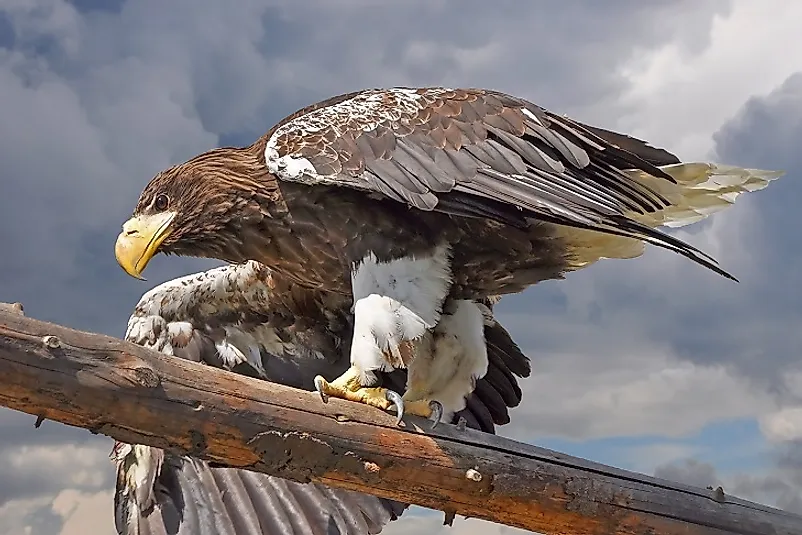White-Tailed Eagles - Animals Of Eurasia

Everyone knows of the Bald Eagle. It is America’s national bird, appearing on the Presidential Seal and in the logos of most U.S. Federal agencies. Even the Steller’s Sea Eagle enjoys widespread notoriety throughout its range of the coastline of northeast Asia, particularly the Kamchatka Peninsula. But it is the White-tailed Eagle that enjoys the largest habitat range, and the eagle being the sole focus of this article.
5. Physical Description
Considered the fourth largest eagle in the world, white-tailed eagles are measured to have a length between 26 to 37 inches and a wingspan ranging from 5.8 to 8.0 feet, with an average wingspan of 7 feet, making them having the largest midpoint wingspan of an eagle. Adult eagles are generally grayish-brown with a slightly paler head and then their eponymous white tail feathers; and like many of other species of eagles, they have yellow talons.
4. Diet
While a white-tailed eagle’s diet is varied, like most eagles, they often prey on fish, birds, and small mammals, which can range from voles to lamb and deer calves. Many of the birds are largely scavengers, pirating food from otters, other raptors, and even fisheries and carp ponds will be exploited by the eagles when opportunity meets them. Their daily food requirement is between 500 to 600 grams, or a little over a pound.
3. Habitat and Range
The white-tailed eagle is present and has a range throughout all of Europe and Asia, with small populations present in southwestern Greenland and western Iceland. Thus, the eagles require a very large and open expanse of lakes and coast and river valleys, often within the boreal forest climate regions, but also reaching into tundra and even to the Hawaiian Islands where the eagles are only vagrants. The eagles, of course, prefer undisturbed cliffs and open stands of old-growth forest for their nests. Their nests are often not only large but reused, sometimes for many decades, passed down through successive generations. Currently, about 50-74% of the total population is based in Europe, with many of the eagles migrating to continental Europe and southern Asia for the winter.
2. Social Behavior
Like other eagle species, they pair for life and are monogamous, but if one dies then replacement is an option often quickly chosen, apparently. The courtship between eagles involves an aerial display, finishing with the pair locking talons in midair, and spiraling towards the ground in a series of cartwheels before separating only a few feet above the ground and soaring back into the sky again. Sometimes, concentrations of 30 to 40 eagles have been observed and recorded to roosts when there’s an abundance of food around. And in Norway, the white-tailed eagle and the golden eagles enjoy a coexistence not seen anywhere else throughout each species range.
1. Reproduction and Life Cycle
The eagles become mature and begin breeding when they are 5 to 6 years old. During the months of March and April, the female will lay 2 to 3 eggs over a period of 2 to 5 days, before incubating them for 38 days for each egg. The eggs do not hatch all at once, as often seen on TV, but over a couple of days, after which while the chicks will be tolerant of each other, there may be some competition, with the oldest one being the dominant. The male will provide food for the female and young for the first three weeks before they're capable of feeding themselves in the nest at 5 to 6 weeks old. They become able to fly when they're 10 to 11 weeks old but still remain close to the nest, as they are still dependent on their parents for another 5 to 6 weeks. Overall, white-tailed eagles enjoy a long average lifespan of around 21 years.











